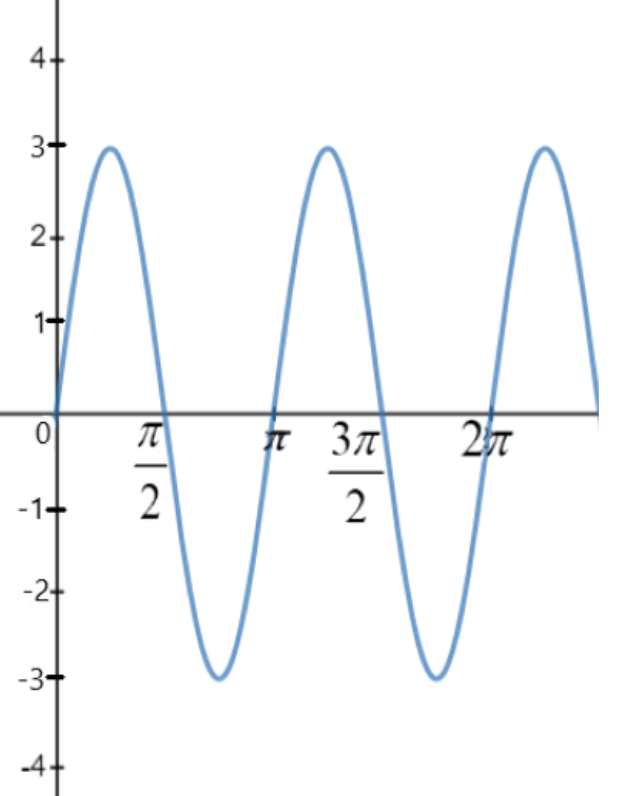
How do you graph $y = 3\sin 2x$ ?
Answer
462.3k+ views
Hint: We are given a function of sine that we have to plot on the graph. For plotting any function on the graph, we first convert the given function to the standard form and then compare it with the standard equation, this way we can find out how the graph should be plotted. The standard form of the sine equation is $y = A\sin (Bx + C) + D$ .
Complete step by step solution:
Comparing $y = 3\sin 2x$ with the standard form $y = A\sin (Bx + C) + D$ , we get –
$A = 3,\,B = 2,\,C = 0\,and\,D = 0$
Thus, the given sine function has peak values at 3 and -3, that is, it oscillates between 3 and -3 and the given sine function completes two oscillations between 0 and $2\pi $ , but for plotting the graph, we have to find out the period of the function. Period of a sine function is –
$
p = \dfrac{{2\pi }}{B} \\
\Rightarrow p = \dfrac{{2\pi }}{2} = \pi \\
$
That is the given function repeats the oscillation after every $\pi $ radians, it completes 1 oscillation in the interval 0 to $\pi $ .
Now, We know all the quantities for plotting the graph of the given function, so the graph of $y = 3\sin 2x$ is plotted as follows –

Note: We know that the general form of the sine function is $y = A\sin (Bx + C) + D$ where
- A is the amplitude, that is, A tells us the value of the peaks of the function.
- B is the frequency, that is, B tells us the number of oscillations a function does in a fixed interval.
- The horizontal and vertical shift of a function is denoted by C and D respectively. The value of C and D is zero for the given function, so there is no horizontal or vertical shift.
Complete step by step solution:
Comparing $y = 3\sin 2x$ with the standard form $y = A\sin (Bx + C) + D$ , we get –
$A = 3,\,B = 2,\,C = 0\,and\,D = 0$
Thus, the given sine function has peak values at 3 and -3, that is, it oscillates between 3 and -3 and the given sine function completes two oscillations between 0 and $2\pi $ , but for plotting the graph, we have to find out the period of the function. Period of a sine function is –
$
p = \dfrac{{2\pi }}{B} \\
\Rightarrow p = \dfrac{{2\pi }}{2} = \pi \\
$
That is the given function repeats the oscillation after every $\pi $ radians, it completes 1 oscillation in the interval 0 to $\pi $ .
Now, We know all the quantities for plotting the graph of the given function, so the graph of $y = 3\sin 2x$ is plotted as follows –

Note: We know that the general form of the sine function is $y = A\sin (Bx + C) + D$ where
- A is the amplitude, that is, A tells us the value of the peaks of the function.
- B is the frequency, that is, B tells us the number of oscillations a function does in a fixed interval.
- The horizontal and vertical shift of a function is denoted by C and D respectively. The value of C and D is zero for the given function, so there is no horizontal or vertical shift.
Recently Updated Pages
Master Class 12 Economics: Engaging Questions & Answers for Success

Master Class 12 Maths: Engaging Questions & Answers for Success

Master Class 12 Biology: Engaging Questions & Answers for Success

Master Class 12 Physics: Engaging Questions & Answers for Success

Master Class 11 English: Engaging Questions & Answers for Success

Master Class 11 Computer Science: Engaging Questions & Answers for Success

Trending doubts
The gas that burns in oxygen with a green flame is class 12 chemistry CBSE

Most of the Sinhalaspeaking people in Sri Lanka are class 12 social science CBSE

Draw a labelled sketch of the human eye class 12 physics CBSE

Differentiate between homogeneous and heterogeneous class 12 chemistry CBSE

Write a short note on Franklands reaction class 12 chemistry CBSE

Differentiate between insitu conservation and exsitu class 12 biology CBSE




